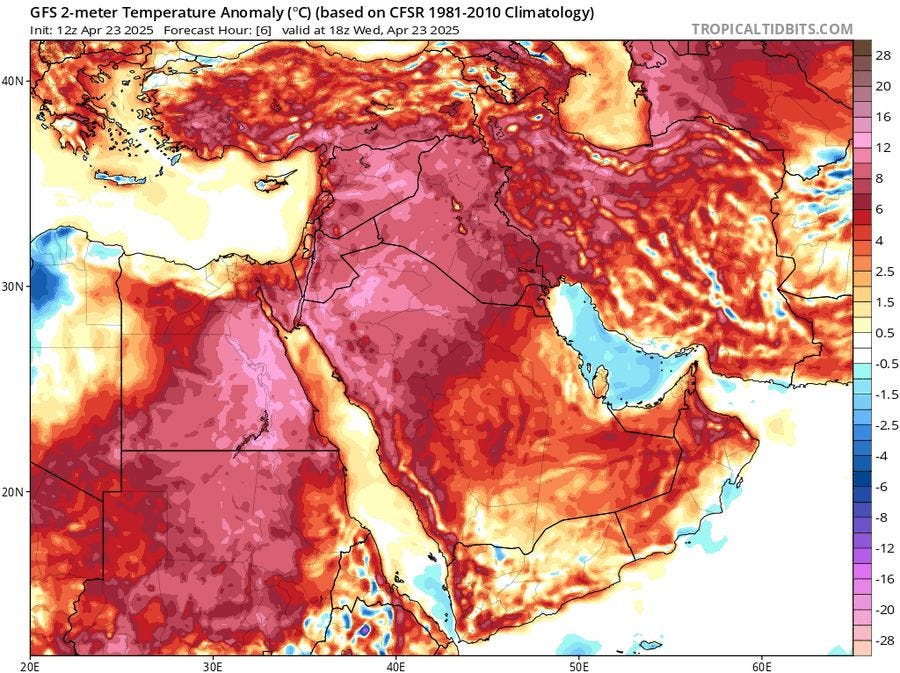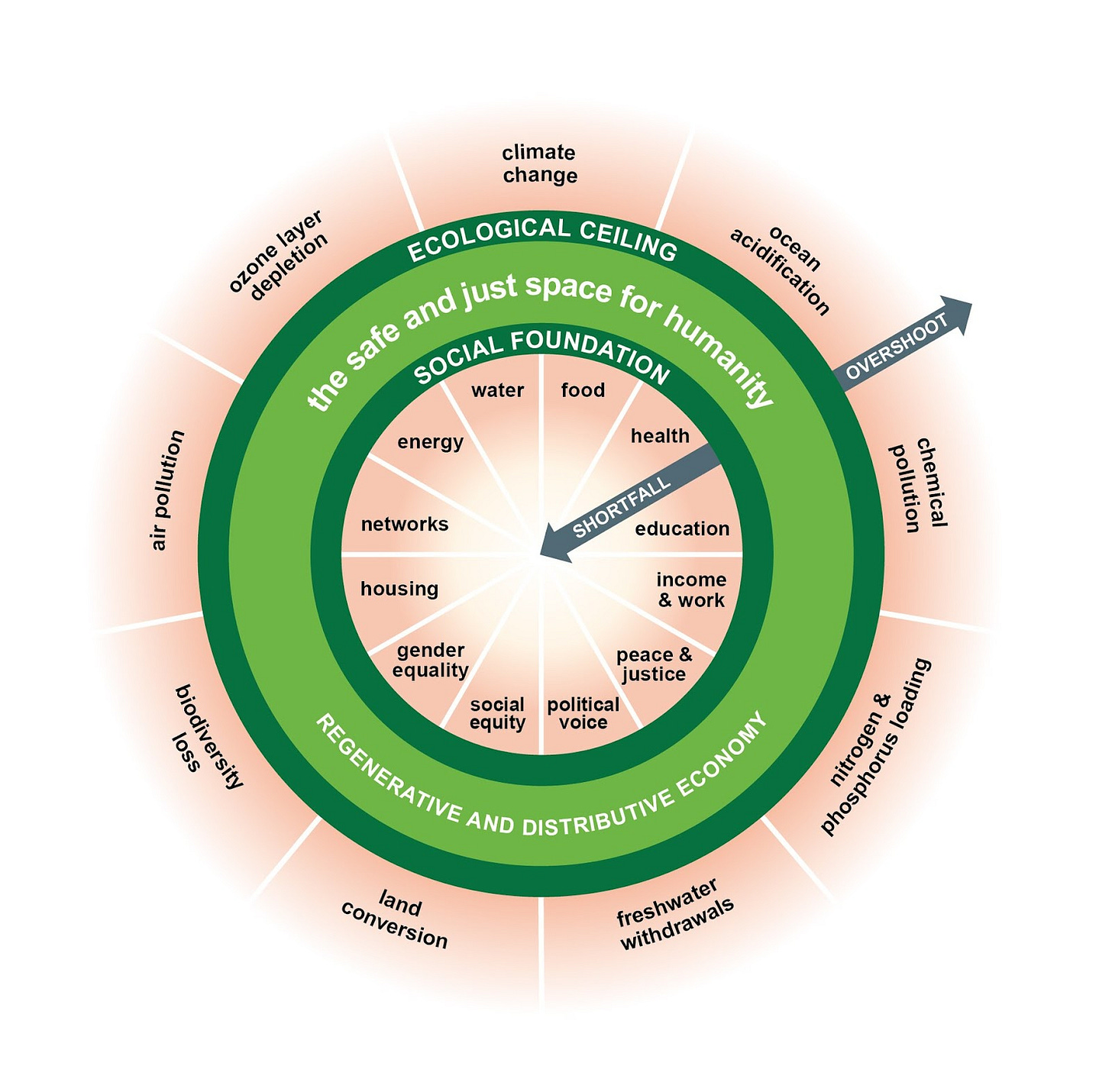Last Week in Collapse: April 20-26, 2025
Widespread pollution of all sorts, India-Pakistan tensions escalate, the death of a Pope, and Arctic sea ice at record lows. So much for Earth Day; this is Human Century.
Last Week in Collapse: April 20-26, 2025
This is Last Week in Collapse, a weekly newsletter compiling some of the most important, timely, useful, soul-crushing, ironic, amazing, or otherwise must-see/can’t-look-away moments in Collapse.
This is the 174th weekly newsletter. You can find the April 13-19, 2025 edition here on Reddit if you missed it last week. Thank you for subscribing to the Substack.
——————————
The world’s oceans and coral reefs are undergoing their worst bleaching event on record. Scientists say this event has lasted about 48 months (and counting), and has affected more than 80% of earth’s coral reefs.
Peat bogs are burning at a Polish nature reserve, but authorities say the wildfire is under control. The U.S EPA has taken offline a map of dangerous chemical facility locations; now find such sites in your area, you must now submit a FOIA request. Meanwhile, a 6.3 earthquake in Ecuador killed at least 20 and damaged infrastructure. The UK’s first few months of 2025 have been their driest in 40+ years; Türkiye’s start to the year was their driest in 35+ years... Flash flooding in Nairobi killed 7.
Decades of water mismanagement are leading to a serious reckoning in Iran, a “day zero” when Drought (already a strong factor in southern Iran) will have forced “climate refugees” towards the north, too crowded to sustain such numbers. A study was done in 2014 that forecasted Iran’s water to run out by 2029. More than two thirds of irrigation water is lost to leaks (compared to Iraq’s roughly 50%), and about 80% of water is used for farming. Dam-building and well-drilling has also been instrumentalized as a tool in Iran’s ethnic conflicts, with consequences for those who challenge this status quo.
Criticism is already emerging over Brazil’s chairmanship of the November COP30 conference in Belém (pop: 2.4M), Brazil. Some take issue with a new highway being built through part of the city’s jungle, and Brazil’s expanding oil extraction (at over 4M barrels per day, it is the world’s 7th largest oil “producer”). Brazil’s oil exports are projected to peak in the 2030s. Furthermore, Brazil and other countries are being criticized for overreporting the carbon sequestration done by their forests to balance their carbon budgets. It was reported last year that the Amazon rainforest itself was under threat of no longer being a carbon sink, and will become a source when deforestation reaches a certain point.
A study out of the European Geosciences Union claims that “the Amazon rainforest and permafrost, which are the two major tipping points within the Earth's carbon cycle” threaten a high probability of runaway climate tipping points under SSP2-4.5, the intermediate climate pathway which expects 2 °C warming by about 2050, and approximately 3 °C by 2100. “Our most conservative estimate of triggering probabilities averaged over all tipping points is 62 % under SSP2-4.5, and nine tipping points have a more than 50 % probability of getting triggered.” Some of the tipping points include: boreal permafrost collapse, AMOC collapse, Amazon rainforest dieback, Labrador-Irminger seas convection collapse, and loss of mountain glaciers.
A study found that coastal blue carbon ecosystems—like the Baltic Sea floor studied here—are at risk of becoming a source of CO2. The Baltic Sea already is, because of a combination of dredging, bottom trawling (which disturbs sediment on the seafloor) and storms (which also disturb seafloor sediment). Brutally hot nights in Iraq (over 31 °C / 88 °F in some places) set records, while chronic water shortages worsen across the region.
Drought in southern & northern Africa is expected to worsen in the coming months. Research suggests that Canada’s 2023 wildfires caused so much air pollution that temperatures in and around New Jersey dropped 3 °C. In the present day, a heat wave rolled through Pakistan, Utah’s governor declared a state of emergency over worsening Drought, and heat records were broken in Thailand.
How can we quantify the damage done to our environment? A paywalled study from last week tries to answer this, and determined that Chevron “caused between US $791 billion and $3.6 trillion in heat-related losses over the period 1991–2020.” A summary of the study pinned down the damage from the world’s largest corporations at approximately $28T USD, presumably over the same period of time. Earth Day passed without much notice; scientists say we have transgressed six of the nine planetary boundaries: “climate change, ocean acidification, stratospheric ozone depletion, biogeochemical flows in the nitrogen cycle, excess global freshwater use, land system change, the erosion of biosphere integrity, chemical pollution, and atmospheric aerosol loading.”
The British government has approved a solar reflection geoengineering project in which they will spray aerosols into the atmosphere within weeks. They hope to therefore brighten clouds, which will reflect solar radiation (sunlight) back into space. Meanwhile, a pre-publication study into China’s reduction in sulfur dioxide (SO2) pollution found that the measure was good for lung health, but accelerated global warming.
Sea surface temperature anomalies continue at almost-record highs. Water reserves in Athens are lowering. Eastern Europe felt a heat wave earlier this week. Parts of Japan felt new April heat records; as did Vanuatu. The observatory at Mauna Loa recorded 430 ppm of CO2. A hailstorm in Catalonia damaged 50,000 hectares of crops (equivalent to a bit less than Guam or Ibiza).
——————————
Bird flu contact tracers believe that bird flu was transmitted to U.S. dairy cows beginning from a single transmission event in 2023. This H5N1 was then exchanged among cows (and other animals) and then back to birds, where it then spread more widely. Experts believe that the virus is likely to evolve further through transmissions among mammals—where it then may one day make the jump to become human-human transmissible. The good news? Scientists made a vaccine that shows great promise for mice. Vietnam meanwhile recorded its first 2025 bird flu case in a human.
A study in Nature Scientific Reports examined mortality rates from COVID in the year 2020, and attempted to find which factors were most effective in mitigating deaths. Countries with stronger “rule of law,” rainfall, and sea borders tended to have better survival rates from COVID. Interestingly, they found “no evidence that the number of physicians per 1,000 people is a good predictor of excess mortality. Nor do we find evidence for a (partial) correlation with the number of hospital beds per capita, government spending on healthcare, or overall spending on healthcare.” The study also found that “an additional $10,000 {per capita income} per year is associated with 0.03 fewer deaths. However, the results suggest no impact of our other measures of macroeconomic performance — unemployment, inflation and public debt.” Countries with school closures had higher death rates, but the authors believe it was “because countries struggling most to manage the pandemic were more likely to have to close schools, rather than school closures somehow driving excess mortality.”
The U.S. Dollar dropped to its lowest (measured against 6 other currencies) in 3 years, following tumult in the U.S. stock market. The U.S. FDA is pausing its milk safety testing after a government layoff fired about 2,000 FDA workers. American tariffs are prompting more government borrowing across the world, pushing states closer to a financial disaster. Shadow banks meanwhile reportedly manage “49% of the world’s financial assets”......that’s 15x of what they controlled in 2008.
About 650,000 starving people in Ethiopia are losing their food aid as a result of UN budgetary issues. Another 3M are expected to see much of their aid from the World Food Programme be cut in the coming weeks, based on current financial pressures. “Conflict, instability and drought” are the key factors behind this famine. Meanwhile a paywalled study in Nature Food claims that “diets that limit meat consumption to 255g per week” (chicken & pork only; beef is a no-go) are sustainable in line with the Paris goal of 1.5 °C (lol).
The American Lung Association released its 155-page “State of the Air” report—in which they claim Los Angeles is the nation’s city with the worst ozone pollution (a record L.A. has kept for 25 of the last 26 years). 2024 was also the 7th year on record of overall worsening small particle pollution, largely from wildfires. The report is mostly composed of data tables. Meanwhile, a short Reuters article casts some light on the most air-polluted metro area in the world in India: “Everything is covered with dust or soot.”
Keep reading with a 7-day free trial
Subscribe to Last Week in Collapse to keep reading this post and get 7 days of free access to the full post archives.








